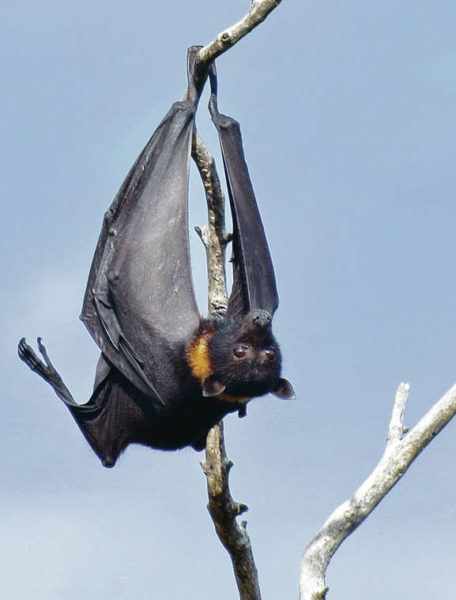Published in the Ocean Watch column, Honolulu Star-Advertiser © Susan Scott
May 18, 2019
One of the many joys of walking along the beach in Townsville, Queensland, Australia, where our sailboat Honu is currently moored, is the bats.
Dracula and other vampire tales have given bats a bad name. While there are indeed vampire bats that feed on blood, those bats are only 3.5 inches long and live in tropical Mexico, Central America and South America where they prey on cattle and horses (and people when possible) in the dark of night.
The bats I love to visit during my coastal strolls are 10-inch-long vegetarians with 3-foot wingspans known as Pteropus alecto, or black flying foxes. The common name comes from their resemblance to real foxes, with pointed snouts, big round eyes and erect ears. Flying foxes’ attractive faces are complemented by lovely orange ruffs around their necks and pale eye rings.
 A black flying fox in its camp of dozens,
A black flying fox in its camp of dozens,
maybe hundreds, just past Kissing Point, Townsville.
©2019 Susan Scott
Flying foxes are intelligent, social animals that forage for nectar, flowers and fruit at night. By day they hang upside-down on tree branches using their toes or fingers.
Fruit bat colonies, called camps, are raucous places where the bats court, mate, raise their young and squabble over space. Watching and listening to them, it’s hard to imagine that the animals get any sleep at all.
Flying foxes (and all bats) are mammals. Females give birth to one live young, quite a feat when dangling upside-down. The newborns hang onto their mothers for dear life, suckling milk from nipples located near the mother’s armpits.
[Image]
Flying foxes at BatReach Rescue in Kuranda, Australia. ©2016 Scott R. Davis
Mothers fly with their babies clinging to their bellies. When a baby can roost on its own, the mother leaves it at night to forage. After several months, the offspring joins the mother and learns how to find food.
Bats are the only mammals that can fly, (the little sugar gliders here only glide.) Flight is possible due to thin sheets of elastic membranes that attach to the bat’s’ arms and finger bones, as well as to the sides of their bodies and legs.
Wings are handy for flight but bats also use their wings like jackets, wrapping around themselves when cold. When hot weather comes, the bats flap their wings like fans to cool themselves.
Australia hosts about 80 bat species. The little ones, called microbats, can eat up to 50 percent of their weight in insects each night, and thus serve as pest control.
Flying foxes, also called megabats, pick up pollen when foraging for nectar, transferring it from flower to flower. The fruit eaters spread native fruit seeds through the forest as they migrate, sometime hundreds of miles.
Because the tide was out when I visited the flying foxes, I walked into the exposed mangrove roots for a better view. In seconds, dozens of vampires attacked me. Not bats, but midges, the smallest of the blood-sucking flies here. Days later, I’m still itching from those little rascals, but I don’t mind. I figure a few vampire bites are a small price to pay for getting to spend part of my vacation at Camp Flying Fox.